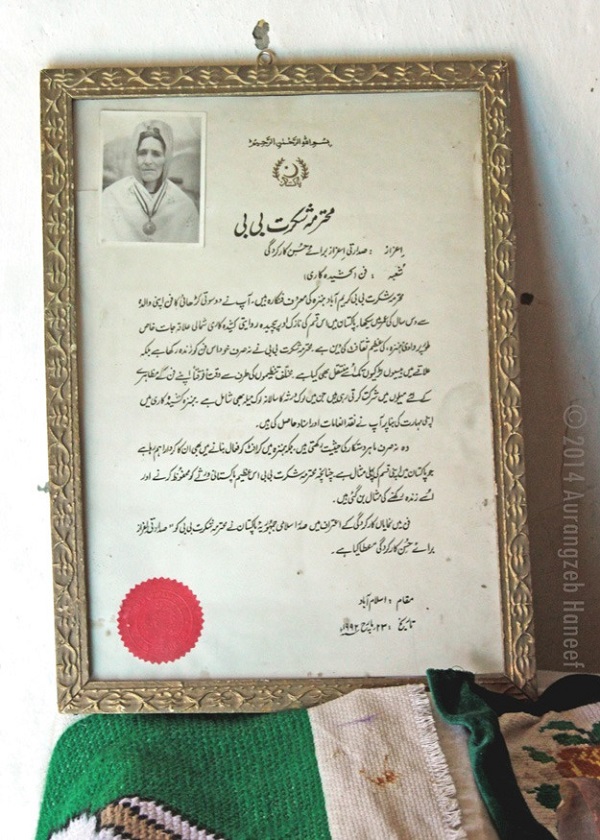Written by: Haroon Shuaib
Posted on: August 04, 2022 |  | 中文
| 中文
Handicrafts on display in Karimabad, Hunza
The natural beauty of Hunza Valley has few parallels and this mountainous region is home to a rich culture. For centuries, Hunzakuts (the people of Hunza) have been carrying the legacy of excellence in making beautiful and distinct jewellery, embroidery, pottery, architecture and woodwork. Although tourism remains the mainstay of the economy of Hunza, sale and export of handicrafts to national and international markets generates additional revenue for the people, who are also famous for their industrious nature and the legend of their longevity.
Hunza region is situated at the convergence of the three greatest mountain ranges: Karakoram, Himalaya and Hindukush. It is a kaleidoscope of cultural influences from neighboring regions such as China, Tajikistan, Afghanistan, Kashmir and Ladakh. The richness of these influences makes the ethnographic and cultural landscape of Hunza valley as alluring as its landscape.
The region is blessed with natural precious and semiprecious stones, such as aquamarine, topaz, emerald, ruby, pollucite, rutile quartz, morganite, apatite, spinel and pargasite. People of Hunza have been cutting, strewing and embedding these gems together to form some of the most delicate signature handmade Hunza jewellery. This jewellery is distinctive due to its elegance, distinct patterns and use of these beautiful stones. A visit to Hunza is incomplete without a visit to a local jewellery shop and it would take a lot of discipline to not over indulge.
The intricate and elegant woodwork produced by Hunzakuts is equally outstanding. Carpentry was traditionally a male-dominated occupation in Hunza, but recently it has also been taken up by female artisans. Blessed with quality wood, including the timber obtained from apricot, walnut, almond, cherry and pear trees that abound in the area, which is used to make furniture, doors, utensils, musical instruments and decoration items. Intricate and elaborate designs, mainly centered around geometric patterns can be seen in old architectural edifices and furniture. While use of wood in architecture has reduced over time, Hunzakuts have turned this legacy of wood carving into a cottage industry of smaller everyday items. One such artisan is Shafqat Karim, who gave up being a policeman to follow his passion for wood work and carving. Each autumn season, he spent months collecting wood from old trees that had fallen down during harsh and extended winter spells of the Upper Hunza valleys. Cutting down a tree was totally out of the question for the ever-conscientious Shafqat to make items, such as salad servers, bowls, dishes and serving spoons.
Like almost all regions of this part of the world, Hunza too has its own tradition of weaving rugs and carpets. This combination of art and skill is practiced by both men and women. Since people of Hunza have a close association with farming livestock as part of their lifestyle, the raw material used for making these vivid carpets is hides and wool of lambs, yaks and goats. Hunza’s carpets are distinct as they are not mass-produced and are mostly handmade.
Women of Hunza, like other rural communities of Pakistan, learn embroidery from a young age and learn this art from their mothers and grandmothers. Hunza women have a tradition of wearing a beautifully embroidered cap under a long chador (a cloth used by women for covering the body). Hunza’s embroidery typically has brightly coloured geometric designs and also finds its place on new items of utility, such as wallets, purses, belts, bell pulls, clutch bags, pen holders, pincushions, slippers, cushion covers and other knick-knacks for more urban consumers, especially tourists that throng the streets of many little and fascinating towns of the Hunza valley. One such noteworthy artist has been Shukrat Bibi of the Karimabad town of Hunza, who not only practiced the art of Hunza embroidery all her life, but also taught her art to hundreds of other young girls and women of the region. In recognition of her invaluable contributions, she was awarded the President’s Pride of Performance Award in 1992. Her efforts contributed to an increase in the incomes of many households as patrons of the traditional art of Hunza do 2 thread embroidery (do sutti karahi) . Men wear long woolen gowns in Hunza to protect themselves from its harsh winter. These gowns are now worn by men mostly as ceremonial robes and are also embellished by a special style of embroidery in earthy tones. Many social enterprises such as Karakoram Area Development Organization (KADO), Aga Khan Foundation (AKF) and Hashoo Foundation (HF), support and promote handicrafts from Hunza through linkages, value addition, innovation and training in latest market trends. Many websites are now using e-commerce platforms to market these products from Hunza for global clients.

Shukrat Bibi was awarded the prestigious Presidential Pride of Performance Award in 1992. (Photo, Aurangzeb Haneef)
The list of the handicrafts that Hunzakuts have been practicing generation after generation include many others besides embroidery, woodcarving, weaving of cloth and rugs, jewelry-making and musical instruments. Many artisans are also associated with crafts such as basket and mat-weaving, leatherwork, weaponry, tools and crafts of the blacksmith. It is important that while modern technology, influx of a greater number of tourists and connectivity has made handicrafts of Hunza visible and available for a larger number of potential customers, the excellence and quality that is a hallmark of the handicrafts of Hunza should not be compromised.
You may also like: